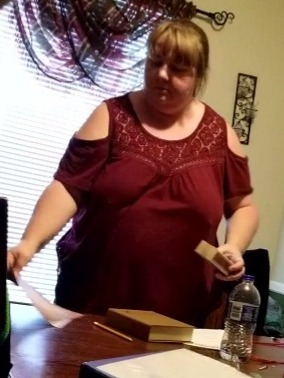#leesburg georgia
Text
They marched for desegregation — then they disappeared for 45 days : NPR

This photo of the group known as the Leesburg Stockade Stolen Girls was taken by Danny Lyons, a former SNCC photographer. It helped confirm the girls' location to their parents and civil rights activists. Danny Lyon/Magnum Photos hide caption
In the early 1960s, civil rights protests were picking up speed across the country. Sometimes, protest marches included children as young as 12 years old.
Usually, children who were arrested at protests were bailed out by activist groups, or eventually released to their parents. But on July 19, 1963, during a march to desegregate a theater in Americus, Ga., a group of Black girls was arrested — and for the rest of the summer, their parents had no idea where they were.
One of those girls was Lulu Westbrook-Griffin.
"We were gung-ho young people who want to change the system," Westbrook-Griffin told Radio Diaries.
Westbrook-Griffin was 12 years old at the time. Her older brother, nineteen-year-old James Westbrook, was a field secretary for the Student Nonviolent Coordinating Committee. With SNCC, Westbrook organized a march to desegregate the Martin Theatre, the only theater in Americus.
At least 40 people attended. But as the marchers approached the theater, local police demanded that they disperse, and began beating them with clubs and setting dogs on them.
"Some of us were taken by our feet and arms and thrown in a paddy wagon, and I was one of them," Westbrook-Griffin recalled.
Westbroook-Griffin's brother escaped arrest. "I told Mom that night: 'They drove her off in a paddy wagon and I have no idea where they went,'" James Westbrook said.
Along with at least 13 other girls, Westbrook-Griffin was transported to a single cell of the Leesburg Stockade — an abandoned, Civil-War-era building more than 20 miles away from Americus.
For the next 45 days, the girls would be subject to squalid living conditions. The stockade lacked running water, plumbing and beds. As the weeks passed, conditions only deteriorated.
"We were putting our waste in the shower drain because the toilet was overflowing," Westbrook-Griffin recalled.
Back in Americus, SNCC activists and parents were focused on locating the missing girls.
"Americus is a small town where everybody knew everybody," James Westbrook said. "It was a network of parents trying to find out, day by day, where their children were."
Throughout July and August, SNCC activists went from jail to jail in search of the missing girls. At one of SNCC's mass meetings, someone mentioned a rumor that the girls were being held in the old Leesburg Stockade.
Danny Lyon was a photographer for SNCC at the time. "James Foreman, who was executive secretary, said to go down and check it out," Lyon told Radio Diaries.
Lyon drove to the Leesburg Stockade after dark. There, he took clandestine pictures of the girls and their living conditions through bars of the building.
Lyon's photos confirmed the girls' location to parents and activists, providing leverage as they fought with authorities for the girls' return. Finally, on Sept. 1 – 45 days after they were taken – the police released the girls to their parents. Danny Lyon's photos appeared in Jet magazine in late September and in a special issue of SNCC's The Student Voice newspaper in 1964.
Westbrook-Griffin and the other girls were never formally charged after the march. They also weren't given a reason for why they were held in the stockade so long.
"Was it to break me? Was it to make me fearful? Was it to teach me a lesson?" Westbrook-Griffin says. She wonders to this day why the girls were kidnapped. "But when you look back at it now, you realize it pretty much was a badge of honor rather than a badge of disgrace. We were part of something that matters."
Lulu Westbook-Griffin and the other girls in the Leesburg Stockade were never formally charged. And local law enforcement never explained why they were held in the stockade for so long.
The stockade is still standing. In 2019, the state of Georgia put a historical marker on the site, acknowledging the incident. It reads, "Because their families were not initially told their location and the girls never faced formal charges, they became known as the Leesburg Stockade Stolen Girls."
#They marched for desegregation — then they disappeared for 45 days#stockade stolen girls of leesburg#leesburg georgia#georgia#white supremacy#right to vote#civil rights movement#kidnapped Black girls#leesburg stockage#sclc#sncc
30 notes
·
View notes
Text
StoryCorps: Leesburg Stockade Girls Recall Time As Civil Rights-Era Prisoners : NPR
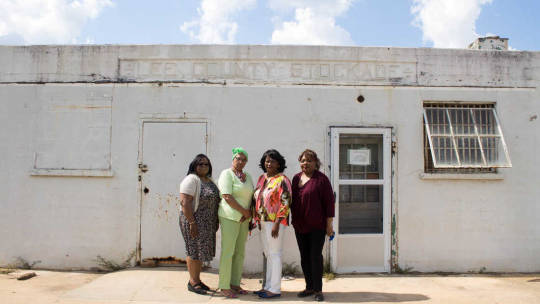
Taken in 2016, (left to right) Emmarene Kaigler-Streeter, Carol Barner-Seay, Shirley Green-Reese and Diane Bowens stand outside the stockade building in Leesburg, Ga., where they were jailed in 1963.
The day Martin Luther King Jr. gave his landmark "I Have a Dream" speech in August 1963, a lesser known moment in civil rights history was unfolding in southern Georgia.
More than a dozen African-American girls, ages 12 to 15, were being held in a small, Civil War-era stockade set up by law enforcement in Leesburg, Ga., as a makeshift jail.
Though they were never charged with a crime, the girls had been arrested for challenging segregation in demonstrations in nearby Americus, Ga. For about two months, the girls slept on concrete floors; there was no working toilet or shower. There were minimal food and water deliveries each day.
"The place was worse than filthy," recalled Carol Barner-Seay at StoryCorps in 2016.
Barner-Seay, who's now 68, had been imprisoned there along with Shirley Green-Reese, Diane Bowens and Emmarene Kaigler-Streeter. At StoryCorps, the four women recounted their time together in the stockade.
"Being in a place like that, I didn't feel like we was human," Shirley Green-Reese, now 70, said.
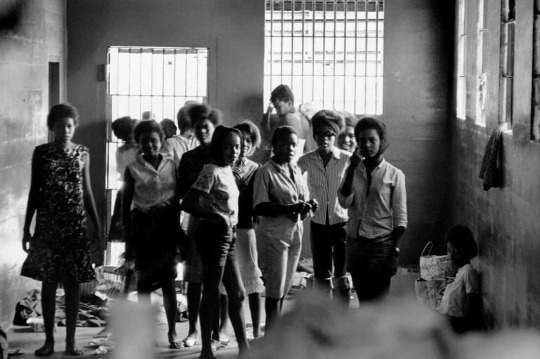
In August 1963, African-American girls were held in a Georgia stockade after being arrested for demonstrating segregation. Left to right: Melinda Jones Williams (13), Laura Ruff Saunders (13), Mattie Crittenden Reese, Pearl Brown, Carol Barner Seay (12), Annie Ragin Laster (14), Willie Smith Davis (15), Shirley Green (14), and Billie Jo Thornton Allen (13). Sitting on the floor: Verna Hollis (15).
Bowens, who's 68, was especially concerned about one of the girls, Verna Hollis. "I was scared Verna was going to die. If she ate, it would just come right back up."
Hollis didn't know that she was pregnant at the time. "We didn't know because we were children," Green-Reese said.
Looking back, Barner-Seay remembered Hollis' strength. "If she complained to anybody, it was under her breath to God, but we never heard it," she said.
Hollis' son, Joseph Jones III, is now 54 years old. A year before Hollis died in 2017, she recorded a StoryCorps interview with him, reflecting on those months she'd been jailed as a teen.
"I was scared and mad that you could treat a human being like they treated us," said Hollis, then 68. "We both could have died in there."
Jones told his mom he, too, was inspired by her strength. "I'm proud of that, and I try to live from that," he said.
'This is us'
The Student Nonviolent Coordinating Committee eventually learned where the girls were and sent photographer Danny Lyon to the stockade to photograph them. When Lyon's photographs documenting their squalid living conditions were published, the girls were released.
When Green-Reese went back home, she says she didn't feel welcomed. "When we got out of that stockade, my classmates and my teachers never asked me where I was coming from," she said. "I felt like I didn't fit in, so after high school, I left the area and moved forward."
She took a job with a library in Savannah, Ga. In the archives at work one day, she saw for the first time one of Lyon's photos of the imprisoned girls, including herself, behind bars at the stockade.
"I said, 'This is us.' "
But Green-Reese didn't share the photo with her coworkers. "I didn't want them to know I was in that jail," she said.
It wasn't until 2015 that the women who had been imprisoned in the stockade got together to discuss their time there.
Bowens says she doesn't do well in confined spaces. "Today, when I got in this elevator, I was about to have a heart attack," she said in 2016. "I just don't want to be closed in, and I don't want to be in the dark."
In the StoryCorps podcast, Emmarene Kaigler-Streeter shared what she'd tell the men who locked her up: that she feels sorry for them. "Because they were not looking at us as children," she said. "They were not looking in the hearts. All they were looking at was the fact that we were black."
Green-Reese says the experience is in her "fibers."
"And I still don't like to talk about it," she said, "but this is a part of all of our lives forever."
#They Were Jailed In Squalor For Protesting Segregation#leesburg stockade#civil rights activists#Black Lives Matter#Black History Matters#georgia#americus georgia#systemic racism#falsely detained#adultification
8 notes
·
View notes
Text

I feel so sad 😞 that no one or even my fan don’t want to say just HELLO to me 😣 maybe nobody cares about me and my career ❤️😇 but despite all this I still love those that love me value me ❤️❤️❤️ if you love me can I get messages ❤️❤️❤️🥰🥰
1 note
·
View note
Text
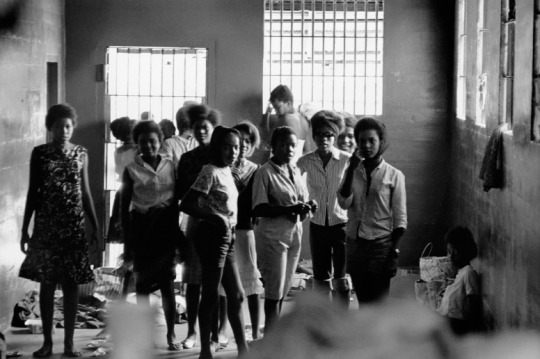
Danny Lyon Teenage Civil Rights Activists Imprisoned in the Leesburg Stockade for Trying to Desegregate a Theater in Americus, Georgia, Leesburg, GA 1963
74 notes
·
View notes
Note
Anne, hows our boys gangsta doing? Did rock Dwayne found his lady love?
Unfortunately not, because it's very busy here in Leesburg. I don't know if you heard about it but Joshie Pooh was heartbroken because of a peach from Georgia 🍑. (Yes Jen because of you! @georgiapeach30513 👀) We tried our best to make him feel better.

#Mr Aldi knows some good dad jokes#of course it's Jen's fault#Nancy said Lola is a heartbreaker but it's actually Jen
9 notes
·
View notes
Text
Everything Changed At 21

Luke Bryan fanfiction!! Y/n L/n gets to go to Luke's concert on her 21st birthday. He is her favorite country music star. But never in a million years did she imagine he would take an interest her. A struggling writer compared to the biggest name in country music. Will she be able to handle the life in the spotlight and a crazy tour schedule?
1 - Margarita from Him
2 - Should I Call?
3 - Partying with Luke
4 - Cowboy's Question
5 - Evening Under Stage Lights
6 - Bryan's New Girl
7 - Bo and Tate
8 - Duet With Me
9 - We're Good Together
10 - The Nights Not Over
11 - Truly in the Spotlight Now
12 - Why'd You Follow Me
13 - I See Only You
14 - Double Dating Friday Night
15 - Rain Won't Hurt Ya
16 - Leesburg, Georgia
17 - Can You Keep A Secret??
18 - I'm Callin' You Baby
19 - Outside Country On
20 - Chloe's In Trouble
21 - Closer to Knockin Boots
22 - More Than One Favorite
23 - Friends Duets
24 - Ready to be Mrs. Bryan
25 - My Dream Wedding
26 - Honeymoon as a Bryan
27 - Premature Baby
28 - Code : Little Bryan
29 - Back on the Road
30 - Country On
31 - Family Dynamic
???
Comments really appreciated ❤️
Tag list @abaker74 @bvbwestfall
Caroline and Luke are divorced in this. (Just easier to write the book that way...)
#Everything Changed At 21#luke bryan#luke bryan fic#luke bryan fanfiction#luke bryan songs#country music#country#muscician#writer#x reader#bellarkeselection#wattpad fanfiction#ask box is open for feedback#comments really appreciated
10 notes
·
View notes
Photo

Happy Monday from me & my favorite mug ☕ (at Leesburg, Georgia) https://www.instagram.com/p/Ckq_FDHu1kvcxzNK2CVz2T_ILbdJPtvJt1wXXg0/?igshid=NGJjMDIxMWI=
2 notes
·
View notes
Text
De Kalb County Georgia Male Arrested, Charged With Murder, Shooting Restaurant Manager Multiple Times Killing Him Inside Of Georgia Little Caesars – Atlanta Georgia reporting
The Georgia Bureau of investigation and the Lee County Sheriff’s Office arrested and charged Daquan Divonte Harris, age 28, of Lithonia with felony murder and aggravated assault in connection to the death of Manager Joseph Dorminey, 50, of Leesburg, Georgia.
0 notes
Text
#anybody want their pussy eat in Leesburg Georgia tonight
1 note
·
View note
Link
Luke Bryan Has Had Quite The Transformation Luke Bryan was born... https://dev-usalivenews.pantheonsite.io/luke-bryan-has-had-quite-the-transformation/?feed_id=35699&_unique_id=65ad85b042087 #movie film movies
0 notes
Text
Leesburg Stockade
The story of this photograph is one of the best examples of photographs being able to do something that words alone cannot do which highlights the significant role that photography had in the Civil Rights Movement
This is a photograph of over 30 girls imprisoned at Leesburg Stockade in August 1963. How did they get here? In 1963, this group of teenage girls in Americus, Georgia, took part in a SNCC-organized civil rights protest challenging segregation laws at the local movie theatre where they attempted to buy tickets from the front entrance rather than the designated "coloured" ticket window in the back alley led to their arrest by local law enforcement. In an attempt by local law enforcement to keep the news quiet, the girls were secretly transported to the Leesburg Stockade, a decaying Civil War-era jail, where they were held in unsanitary conditions for 45 days. The jail was known for its harsh conditions, limited amenities, and absence of proper legal procedures. The girls had little to no food and water over the 45 days. On top of the harsh conditions, many of the girls’ parents were unaware of their kids’ whereabouts during this time but as time went on, word started to spread about what had happened to the group of girls.6
It took 45 days and there was virtually no coverage of these missing girls from any media outlets. Even though people knew what was going on, the news was not being spread about the missing girls from Americus, Georgia. Words were being spread but there were no photographs of the girls to broadcast with the context.
SNCC’s own Danny Lyon was made aware of the girls’ location and he was sent to get photographs of the imprisoned girls in hopes that it would help set them free. Danny Lyon made the trek from SNCC’s headquarters in Atlanta, Georgia to Americus and then a plan was formed to sneak Lyon into the Leesburg Stockade. Once Lyon was snuck in and the guard was distracted, Lyon was able to photograph the condition of the girls in the jail. He gave hope to the girls and got out of there so he could develop the film back in Atlanta to produce these images for the public.7
Danny Lyon got the file processed immediately when he returned to Atlanta and SNCC put the photographs of the imprisoned girls along with the story in SNCC’s newspaper, The Student Voice. The story and photographs spread through other African-American newspapers and newsletters and soon gained national attention. Lyon’s photographs with headlines “Kids Sleeping on Jail Floor: Americus Hellhole for Many,” and "GA Marchers Kept in Filthy, Stench Filled Jail.” With the masses hearing about this story and seeing the photographs with their own eyes, the Georgia police released the girls back to their families and none of the girls were charged.8
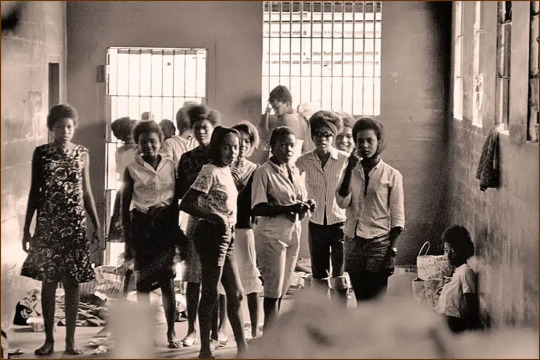
Photograph of the girls imprisoned at Leesburg Stockade, 1963, Danny Lyon, Memories of the Southern Civil Rights Movement
When you look at this photograph, you can see the girls all standing in the room and looking at the camera. Some have smiles on their faces as they look excited that hope may be afoot. Others look very unhappy and it appears almost as if the hope has been taken from them. You can see how this photograph along with the context would make an impact on the public as you can see these little girls are in the room with minimal amenities and bars on the windows. Sometimes words do not do enough but the photograph can say what words cannot quite grasp as you see these little girls in the jail who were arrested due to their fight against segregation.
These photographs are significant because they showed the crucial role of photography in the Civil Rights Movement and the work that SNCC was trying to do to fight segregation. Photography was crucial because it caused people who saw the injustices in photographs to act. They acted because these kinds of photographs are evidence that what is being said is actually true and not exaggerated. Another thing photography does as we have covered in the course is that it can have an emotional response on the one viewing the photograph. This emotional response can prompt action which is something that words cannot always do. We can see how Lyon’s photographs triggered a response that resulted in the girls being set free back to their families.
The response to Lyon’s photographs of the imprisoned girls shows how extremely important these photographs were in the Civil Rights Movement. The ability to transport the viewer into the image is a necessary action that took place repeatedly to gain support and stir action in the Civil Rights Movement.
0 notes
Text
It would be easy to drive right by the Lee County Stockade. The decrepit white concrete building sits in the shadow of a school bus depot and looks like the kind of place that long ago outlived its purpose. On a breezy, overcast day in mid-January, Shirley Green Reese, dressed in a white pantsuit and silver accessories, stood at the stockade door, directing a stream of reporters, filmmakers and locals to step inside.
She began describing the early morning hours of July 1963 when she and a wagonload of at least 14 other girls ranging in age from 12 to 15 were dropped at the jail more than 20 miles from their homes. They had been arrested just a day earlier during a nonviolent civil rights protest at a movie theater in Americus. Holed up in the stockade for weeks, they waited and wondered if their efforts would have an impact.
“I feel very honored that we can share the story and that some people are excited about it and are accepting of it,” Reese said. “Some can’t believe it happened in 1963, and some still have questions about it.”
Known as the Girls of Leesburg Stockade, their story has been shared by news outlets and in books, films and lectures for the past several decades, but to most Americans, including many residents in the southwest Georgia counties where the events took place, the women are largely unknown. They had joined the movement to be seen as Americans with the full force of civil rights, and like many other young protesters of the era, the details of their stories were subsumed by the larger narrative of the civil rights movement.
Caption

Caption
In 2015 Reese and the nine living Leesburg women collectively broke their silence about the time they spent in the Leesburg Stockade.
Now their memories have worn thin. Some of the women recall details that the others do not, and there are disputes about who was actually jailed in the stockade and for how long. But what the girls from Leesburg Stockade now collectively possess that they did not in the past is the desire for their efforts to be seen, heard and understood.
The stockade is now owned by the local school district. There is talk of preserving the building as a historic landmark. Last year, students at the high school worked to have the girls of Leesburg recognized on a historical marker. The marker, in partnership with the Georgia Historical Society, will be dedicated later this year to commemorate the spirit and sacrifice the girls showed during the summer of 1963.
The young seek a role
The road to the Leesburg Stockade began miles away and years before the girls were locked up.
A nascent civil rights effort had been brewing in that pocket of southwest Georgia as the 1950s gave way to the turbulent ’60s. It centered around Albany, and by 1962 had made its way to Americus, 38 miles north.
Children were encouraged to be part of the movement, as they had been in Albany and in Birmingham. It was a controversial tactic, but one that became a signature of the resistance. If a town could lock up its black children to avoid integration, what would it do to their parents?
“Around April of ’63 is when we started asking the SNCC (Student Nonviolent Coordinating Committee) workers, ‘When are we going to go and test these places and restaurants to serve us?’” said Sam Mahone, one of the early leaders of the Americus-Sumter County Movement. “At first, SNCC didn’t think Americus was ready, but the students didn’t want to wait.”
After a series of mass meetings were held at local black churches to energize the crowds, direct action protests began. The first target was the town’s segregated movie theater.
Having slipped away from home on a Saturday afternoon while her parents were downtown, Reese and her best friend Mae Smith-Davis decided to attend the mass meeting at Friendship Baptist Church. When they arrived, the group was already planning to go to Martin Theater.
The pastor and SNCC workers gave them instructions. Don’t talk to anybody. Follow everyone closely. They joined the line and marched toward downtown.
Law enforcement in Americus responded with brute force: water hoses, cattle prods, nightsticks. They arrested protesters by the scores. Some were adults, but the overwhelming number of those taken into custody were teenagers, some as young as 12. When the city jail filled, surrounding counties offered space. Boys and girls were separated, although they were often held in the same building.
‘No swinging doors in Leesburg’
As the protests continued, the stockade in Leesburg filled with girls.
Paddywagons brought them to the stockade, a remote, low-slung structure surrounded by woods and bordered on one side by a lonely stretch of country road.
The building was by then a relic, gloomy and filthy. Bars covered the windows, but much of the glass was broken, giving easy access to bugs. The stockade’s sole toilet would not flush. There was no soap. Water from the shower head trickled in a thin stream. Day in and day out, the girls were fed either scrambled egg sandwiches or four rare hamburgers a day.
Some of the girls were ill and afraid.
Lulu Westbrook Griffin, 69, had joined the group of protesters at the church knowing she would likely end up in jail, but she wasn’t prepared for the trauma she would feel.
“We weren’t used to going off and staying overnight anywhere,” said Griffin, who was 12 at the time. “We went to church, to school. We didn’t even walk out of the house without our parents’ permission.”
Though she was in the company of other girls, Griffin said the experience left her with bouts of crying and nightmares that would persist well into adulthood. She had joined the movement to feel empowered, but her one act of protest left her feeling weak.
Diane Bowens’ activism had been brewing long before she attended the protest at the theater. By then, she was fully invested in the movement. In the stockade, her commitment didn’t waver, said Bowens, then 13. “If you were going to be a part of it, you were going to be a part of it,” she said. “There were no swinging doors in Leesburg.”
Outside world takes notice
As the days turned into weeks, other girls arrived, a signal to the ones already there that the protests continued back in Americus, 27 miles north. But here, the story of the girls of Leesburg Stockade gets muddled. Some reports have said there were more than 30 girls at the stockade arriving and leaving between mid-July and mid-September, but the only visual evidence of girls being held in the stockade, an image shot by a SNCC photographer, pictures 15 girls. Some girls, those from wealthier families in town, have said their parents paid a fee and got them out before the others.
SNCC kept tabs on what counties the children were taken to and where they were being kept, but they didn’t always have names for every child, especially if the child gave a false name. Which is what Carolyn DeLoatch did.
DeLoatch, then 15, had begged her parents to let her get involved in the movement and they’d relented, telling her she could go to mass meetings but to not intentionally get arrested. But there DeLoatch was in August, locked up.
Their days in the stockade were filled with talking, sleeping, praying, singing and wondering when they’d go home, DeLoatch, now 70, said. The monotony was about as intolerable as the food. But by being in Leesburg, she felt she was doing something important.
“It was bearable because it was all of us together,” DeLoatch said. “We were all demonstrating and we wanted people to know that we wanted to be free.”
After several days, her father paid a fine, possibly $45, she said, and she was brought back to Americus. Her father told her he was proud of her, she said, but within three days, her parents shipped her off to a South Carolina boarding school for black girls.
>> RELATED | More historical markers in Georgia, along with more scrutiny
Reese was still in the stockade when Danny Lyon, a young white photographer for SNCC, showed up. Though their parents had come to look in on them and pass fresh clothing and food through the bars, they didn’t have the means or influence to get them out. “Nobody had any rights. Who were they going to go to?” said Reese.
It was mid-to-late August and the girls pressed their faces against the bars staring at Lyon and stretching their arms through the panes framed with broken glass. He lifted his Nikon and started shooting. “I remember touching them through the bars and we said ‘Freedom’ — that was a code word for the civil rights movement,” Lyon said. “The fact that someone from the outside world was there was incredible to them.”
His visit lasted less than 15 minutes, he thinks, but it resulted in the only known images of the girls and the conditions in which they were being held. Not long after the pictures appeared in the black press, the girls were released. It would be the last time for several decades many of them would acknowledge their connection to the Leesburg Stockade.
Readjusting to their lives
On their return to Americus, the girls were dropped right back into their lives.
“I just remember being happy to get out of there,” Bowens said. Though her arrival home was celebrated, Bowens grappled with her feelings. Her mom pressed to know if anyone had sexually assaulted the girls. Her brother threatened to hurt anyone who had, though no one did.
“I just closed off that part of my life,” said Bowens, 69, who would go outside and sit under the house for hours crying. “Just knowing that someone would treat you like that and do that to you. I was feeling sad. I felt like, Is this it? Is this all there is to life?”
As they journeyed from teens to young women, many of the Leesburg girls’ worlds spread beyond the confines of southwest Georgia to New York, Pennsylvania, Massachusetts and beyond. The 15 girls captured in Lyon’s now famous photo would go on to become pastors, civil servants, educators, authors and public speakers.
When Bowens met her husband, she began to feel better. He had been in the movement as well, and they would talk about all the things that happened in Americus. Raising her four children and building a long career as an inspector in the automotive industry changed her outlook, but Bowens still feels sad sometimes. “Things are better now, but basically things are still the same,” she said.
School had been in session for weeks when Reese walked into Sumter High after her release from the stockade. “Not even the teachers asked where I was coming from,” Reese said. “My grades started falling.”
Reese began diving into extracurricular activities — choir, dance, basketball — to keep her mind off those weeks during the summer. “When I first got out, I didn’t feel whole,” she said. She fed off the energy of close friends who were talented, had a positive attitude and were accepting of her.
After high school, her mother sent her to Savannah to live with her aunts. Reese enrolled in Savannah State University and embarked on an educational journey — ultimately earning a doctorate in philosophy from Florida State University — that would bring her some measure of solace and success. She went on to become the first black female athletic director in the state of Georgia.
“I pushed the stockade out of my mind because I had to get an education. That is what my parents had pushed all our lives,” she said.
Though she spent less time in the stockade, DeLoatch was nonetheless marked by the experience. For her, it was an “awakening.” Before Leesburg, she was sheltered by her educator parents, her father a school principal and her mother a librarian in Americus’ segregated school system. They were part of the town’s tiny black middle class.
Leesburg and the Americus movement taught DeLoatch that civil rights would only come with a sustained fight. She went from being voted “most civic minded” at her boarding school to later participating in the Poor People’s Campaign while a college student at Virginia Union in Richmond, she said. Eventually she became a city planner in Chicago and the mother of two. She watched with pride as her son decided to register to vote as soon as he turned 18: no literacy test to pass; no poll tax to pay.
“There was no problem,” DeLoatch said.
Making their voices heard
Leesburg was a moment in DeLoatch’s life but not the only important one.
“I moved on but I used that to help me become the person I am: the kind of person who doesn’t let anybody push them around; the kind of person who is secure in my personhood,” she said.
But the impacts of childhood trauma can linger, said Vincent Willis, assistant professor of interdisciplinary studies at the University of Alabama. Willis is writing the book “Audacious Agitation,” on the experiences of student protesters in southwest Georgia during the civil rights movement. He’s including a chapter on the larger Americus movement and has interviewed some of the women who were jailed in the stockade as girls, he said.
“That 14-year-old girl is still in there somewhere,” Willis said. “The idea that time heals all wounds, I argue against it. They’re told to get over it, that the battle was won, but there are always lingering effects. There’s always psychological damage.”
Griffin was first among the girls of Leesburg Stockade to share her story on a national platform. In 1996, she saw a book, “Memories of the Southern Civil Rights Movement,” with the photographs Lyon had taken at the stockade. “The pictures had no names. I thought, wow, I need to put a name to these faces,” said Griffin, a retired educator.
She would later write a book and hold speaking engagements at schools. When she began planning a documentary, which premiered in Americus in 2003, she contacted some of the other women, she said. Some of them were still reluctant to speak out about the past, fearing repercussion from locals. A few years later, in 2006, a reporter from Essence magazine wrote a story, and some of the women who had previously been reluctant began to speak out.
Reese returned to Americus for good in 2002. She got involved with local civic organizations, including the Boys and Girls Clubs of Americus-Sumter County and the City Council. “I felt I needed to get back in there and help the kids move forward so they would not have to go through what we went through,” Reese said. For years, she had suppressed her feelings about the stockade, but since returning to Americus, she has vowed to keep telling their story.
“We as a people don’t want to address something like this because they feel like things are better now. But we can’t let them forget the past,” Reese said. “Even if they don’t care, I care.”
#Leesburg Stockade Girls#Danny Lyon#americus georgia#civil rights activists#Black Lives Matter#american history#white supremacy#qualified immunity#badges of slavery
4 notes
·
View notes
Text
Luke Bryan’s Net Worth, Biography, Career, Relationship, Children, Awards & Achievement
Thomas Luther “Luke” Bryan was born on July 17, 1976, in Leesburg, Georgia. Tommy was a grower of peanuts. He intended to relocate to Nashville, Tennessee when he turned nineteen. Chris, his older brother, passed away abruptly in a car accident. Instead of staying in his hometown, Bryan relocated to Statesboro, Georgia, where he attended Georgia Southern University after the family tragedy. After earning a bachelor’s degree in business administration in 1999, he eventually relocated to Nashville two years later.
Visit the link to know more -
https://wideeducation.org/luke-bryan-career-relationship-awards-achieve/
0 notes
Text
From CNN: Stolen Girls: The untold story of the Leesburg Stockade Girls
Stolen Girls: The untold story of the Leesburg Stockade Girls
0 notes
